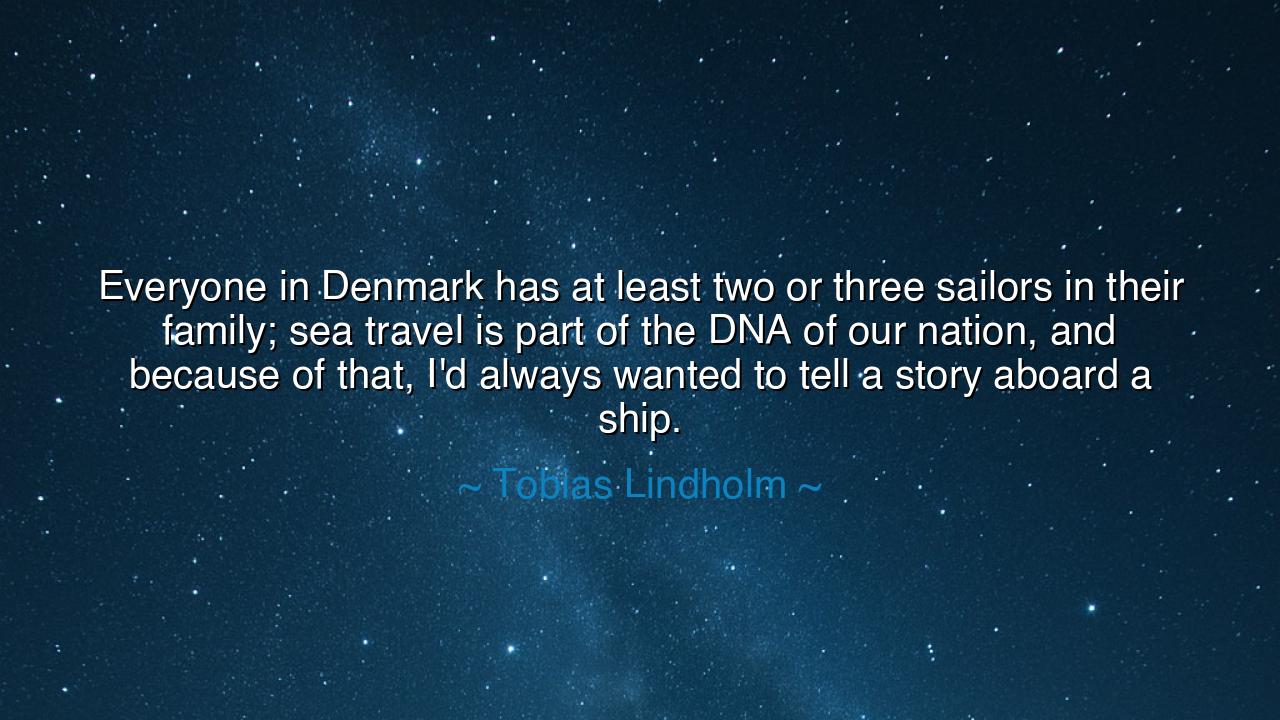
Everyone in Denmark has at least two or three sailors in their
Everyone in Denmark has at least two or three sailors in their family; sea travel is part of the DNA of our nation, and because of that, I'd always wanted to tell a story aboard a ship.






Hear the voice of Tobias Lindholm, who spoke as one born of waves and salt air: “Everyone in Denmark has at least two or three sailors in their family; sea travel is part of the DNA of our nation, and because of that, I’d always wanted to tell a story aboard a ship.” These words are not merely about a nation’s pastime, but about its soul. For some peoples are shaped by mountains, others by deserts, still others by vast plains. But Denmark, like many lands upon the northern seas, was carved in spirit by the ocean, and in its people flows the rhythm of the tide.
The heart of Lindholm’s saying is this: sea travel is part of identity. To say it is “in the DNA” is to acknowledge that a people’s history shapes their very blood, their instincts, their longings. For countless generations, Danes looked to the waters as their path to survival, to trade, to exploration, and yes, to conquest. Ships were not luxuries but lifelines. The sea was both the nation’s challenge and its destiny, teaching courage, endurance, and the art of facing the unknown. Thus, every family carries within them the memory of sailors, whether fathers, uncles, or ancestors long past.
The ancients knew well that geography becomes destiny. The Vikings of Scandinavia, centuries before Lindholm, were masters of the sea. They carried their longships across coasts and rivers, reaching lands as distant as Byzantium and even North America. It was not mere greed or violence that drove them, but the deep restlessness born of a people bound to the sea. They were compelled outward by the call of the horizon, by the knowledge that to remain still was to perish. Lindholm’s words echo this inheritance: the desire not only to live upon the sea, but to tell stories of it, to preserve its presence in art as well as in life.
There is also a truth here about the storytelling of nations. Every people has tales that arise from their deepest struggles and landscapes. The Greeks told of Odysseus wandering across the wine-dark sea. The Polynesians wove chants of voyagers guided by the stars. The Danes, inheritors of sailors, must tell their own tales of ships and storms, of men and women bound together by the deck beneath their feet and the endless horizon before them. Lindholm’s desire “to tell a story aboard a ship” is not a whim, but the fulfilling of a cultural destiny. It is the artist’s task to give voice to the spirit that shaped him.
Yet there is a greater lesson for all: though we may not all descend from sailors, each of us carries within our lineage some elemental force that has molded us. For one it may be the desert, for another the forest, for another the crowded city streets. To know ourselves fully, we must look backward, to the struggles and labors of those who came before, and then forward, to the stories we must tell in their honor. Lindholm calls us to listen to the whispers of ancestry and to shape them into creation.
But let us also remember that the sea is not only history—it is also metaphor. The ship is the vessel of life, carrying fragile souls across an uncertain ocean. To live is to voyage, to face tempests, to chart courses both known and unknown. And to tell stories of ships is to remind humanity that no one sails alone; every crew, every family, every nation is bound together, dependent upon one another for survival. In this way, Lindholm’s words reach beyond Denmark, speaking to the universal truth of human existence upon the waters of time.
The lesson, then, is this: honor the element that shaped your people, and let it shape your art, your work, your life. If your ancestors were sailors, tell the stories of the sea. If they were farmers, sing of the earth. If they were wanderers, write of the road. For to forget the element that forged you is to drift without anchor; but to embrace it is to sail with purpose.
And in practice: seek out the stories of your own lineage. Ask the elders. Read the histories. Walk the lands where your blood once labored. Then find a way to give voice to those forces—through words, through craft, through deeds. For as Lindholm teaches, the sea is not only Denmark’s story but humanity’s teacher: a reminder that we are always voyagers, always storytellers, always seeking new horizons, carried forward by the tides of those who came before us.






AAdministratorAdministrator
Welcome, honored guests. Please leave a comment, we will respond soon